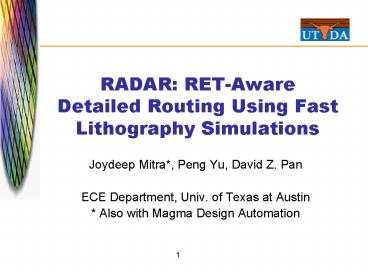RADAR: RETAware Detailed Routing Using Fast Lithography Simulations - PowerPoint PPT Presentation
1 / 23
Title:
RADAR: RETAware Detailed Routing Using Fast Lithography Simulations
Description:
RADAR: RET-Aware Detailed Routing Using Fast Lithography Simulations ... Lithography limitation is a key bottleneck in nanometer manufacturing ... – PowerPoint PPT presentation
Number of Views:34
Avg rating:3.0/5.0
Title: RADAR: RETAware Detailed Routing Using Fast Lithography Simulations
1
RADAR RET-Aware Detailed Routing Using Fast
Lithography Simulations
- Joydeep Mitra, Peng Yu, David Z. Pan
- ECE Department, Univ. of Texas at Austin
- Also with Magma Design Automation
2
Outline
- Lithography Background
- Motivation
- Fast Lithography Simulation
- Edge Placement Error Metric
- EPE map based detailed routing
- Results
- Conclusion
3
Litho Background
- Lithography limitation is a key bottleneck in
nanometer manufacturing - 193nm wavelength gt deep sub-wavelength
- Need extensive RET
- OPC
- PSM
- OAI
- However, RETs mostly are done post-layout
- Major impact from raising the abstraction level
RET-aware layout optimization gt real DFM
4
Lithography process with and without OPC
5
Lithography and RET
k11.0
k10.6
k10.5
k10.4
k10.3
227nm _at_ 0.85NA
136nm
114nm
91nm
68nm
accurate and flexible modeling is key!
The RETsolutions.
(Courtesy ASML)
6
Fast Aerial Image Simulation
- Fast lithography simulation to generate EPE map
- Aerial image is the first order approximation
(resist not considered) - Basic principle pre-compute image density
convolution table for fast table lookup
7
Aerial Image Simulation
- For coherent light entering mask
- Intensity equation at image plane
8
(Contd)
- Using principle of superposition and assuming the
optics system is a linear space-invariant system,
we get the following convolution
9
(Contd)
- In reality, for accurate simulation, the
following corrections are needed - Partially coherent light. Extend to Hopkins
model. - Incorporate effect of lens aberrations into pupil
function P. - Effect of defocus. Add phase error to higher
diffraction orders.
10
Fast aerial image simulation
- Modern techniques by
- Cobb
- Stirniman et. al
- Pati et. Al
- Basic principle Precompute convolutions and
store for fast table lookup. - Our approach is a variation of Cobb.
- Precompute all possible upper rectangular
convolutions within a support region.
11
(Contd)
- Support region 1-4µm in perimeter or a
- multiple of resolution?/NA
12
Edge Placement Error Map
- A concept similar to congestion or thermal
hotspot - Measurement of RET effort
- Work seamlessly with existing CAD flow
13
Table Look-up
Reference point
- Store convolution table for rectangles w.r.t the
top-right reference point
14
Table Look-up Example
Reference point
R2
R1
R3
R4
R
15
EPE Map
- Generate EPE for each control point (points
that may have large edge placement errors) in
design - Each EPE control point has a ranked list of
neighboring wires that contribute to the EPE - Abstract a normalized EPE density for an entire
routing segment
16
RADAR RET-Aware Detailed Routing
- Use EPE map to guide RADAR
- Do not need to run lithography simulations often
- Rip-up-and-reroute
- Focus on EPE hotspots
- Re-simulate EPE only if necessary (rerouted
regions) - Store EPE influencing neighbor list for router to
avoid those neighbors with high EPE impacts - Routing blockage generation and wire spreading
- Protect safe regions with low EPE
17
EPE correction flow
Initial design closure detailed routing
EPE map display
Wire spreading and ripup and reroute
Re-simulate EPE hot spots if needed
Full chip fast litho simulation.
Routing window and blockage creation
Accept new route
EPE below threshold?
Keep old route
18
EPE cutline computation
19
Control point generation
20
Intelligent Ripup Reroute
N1
Routing blockage
S1
N2
21
Experimental Results on a 65nm Industry Design
After wire spreading 12 EPE reduction with
10 WL increase
Initial routing (after design closure)
After RR 40 EPE reduction 5 WL increase
22
Experimental Results
- EPE reduced by 40
- wirelength increased 5
23
Conclusions
- Raised Lithography modeling up to design
implementation level. - EPE map manufacturing effort metric.
- Two routing techniques to reduce EPE.
- RR using blockages showed promising results.
- Future research directions
- Further model speedup to enable
correct-by-construction litho-friendly routing. - New manufacturing-friendly detailed routing
algorithms.































